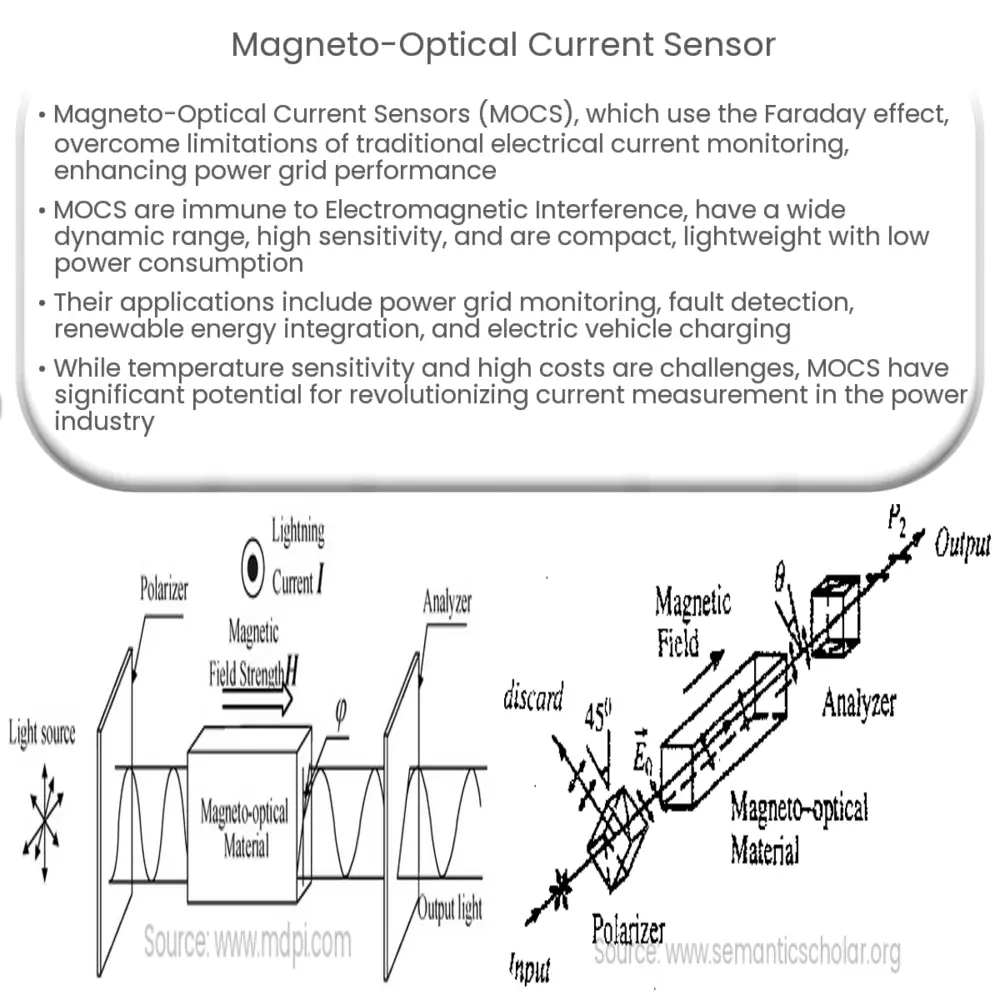Magneto-optical current sensors offer accurate, EMI-resistant measurements for power grid monitoring, fault detection, and renewable energy integration.

Magneto-Optical Current Sensor: Revolutionizing the Future of Power Grid Monitoring
Introduction
In the ever-evolving landscape of power distribution, efficient and accurate monitoring of electrical current flow is essential to maintain grid stability, prevent outages, and optimize energy consumption. Traditional methods like electromagnetic and Hall-effect sensors have been widely employed, but they have several limitations such as size, accuracy, and sensitivity to external magnetic fields. The magneto-optical current sensor (MOCS) has emerged as an innovative solution to address these issues and enhance the performance of power grid monitoring.
Principle of Operation
The MOCS is based on the Faraday effect, a phenomenon in which the polarization plane of linearly polarized light is rotated when it passes through a medium exposed to a magnetic field parallel to the direction of light propagation. This rotation is proportional to the strength of the magnetic field and the distance the light travels through the medium. In the context of a MOCS, the medium is an optical fiber wrapped around the current-carrying conductor. As current flows through the conductor, it generates a magnetic field that induces a rotation in the polarization plane of the light propagating through the optical fiber. By measuring this rotation, the magnitude of the current can be accurately determined.
Advantages over Traditional Sensors
MOCS offer several advantages over traditional current sensors, making them an attractive choice for modern power grid monitoring applications:
- Immunity to Electromagnetic Interference (EMI): As MOCS are based on optical measurements, they are immune to electromagnetic interference, allowing for accurate readings even in high EMI environments.
- Wide Dynamic Range: MOCS can accurately measure a wide range of current values, from very low to very high, without the need for scaling or additional sensors.
- High Sensitivity and Resolution: Due to the linear relationship between the magnetic field and the polarization plane rotation, MOCS provide high sensitivity and resolution, ensuring precise current measurements.
- Compact Size and Lightweight: Optical fibers used in MOCS are lightweight and can be wound around conductors in multiple turns, resulting in a compact and lightweight sensor design.
- Low Power Consumption: MOCS do not require active components, leading to minimal power consumption and a passive sensing solution.
These benefits make MOCS an ideal solution for a wide range of applications, including power grid monitoring, fault detection and localization, and the integration of renewable energy sources.
Applications of MOCS in the Power Industry
Given their numerous advantages, MOCS have found widespread use in various power industry applications:
- Power Grid Monitoring: MOCS can be integrated into power grid infrastructure for real-time current monitoring, helping operators maintain grid stability and prevent outages.
- Fault Detection and Localization: By analyzing the data obtained from MOCS, operators can quickly identify and locate faults in the power grid, enabling timely repairs and reducing downtime.
- Renewable Energy Integration: As the power industry moves towards increased use of renewable energy sources, MOCS can play a crucial role in monitoring and managing the variable current generated by these sources.
- Smart Grids: MOCS can be incorporated into smart grid systems, providing accurate current measurements to facilitate load balancing, demand response, and other advanced grid management functions.
- Electric Vehicle Charging: MOCS can be used in electric vehicle charging stations to monitor charging currents and ensure safe and efficient operation.
Future Developments and Challenges
Despite the numerous benefits and promising applications of MOCS, there are some challenges that need to be addressed for their widespread adoption:
- Temperature Sensitivity: The Faraday effect is sensitive to temperature variations, which can affect MOCS accuracy. Developing temperature compensation techniques is crucial to ensure reliable performance.
- Cost: The cost of MOCS is still relatively high compared to traditional current sensors. Further research and advancements in manufacturing technology are required to reduce costs and increase affordability.
- Standardization and Interoperability: The development of standardized protocols and interfaces for MOCS will facilitate their integration with existing power grid infrastructure and other sensor systems.
Conclusion
Magneto-optical current sensors represent a significant advancement in the field of power grid monitoring, offering numerous advantages over traditional current sensing technologies. As research and development continue, MOCS have the potential to revolutionize the way electrical currents are measured and managed in the power industry. By overcoming the challenges associated with temperature sensitivity, cost, and standardization, MOCS can play a vital role in the evolution of smart grids and the integration of renewable energy sources, ultimately contributing to a more sustainable and reliable energy future.

